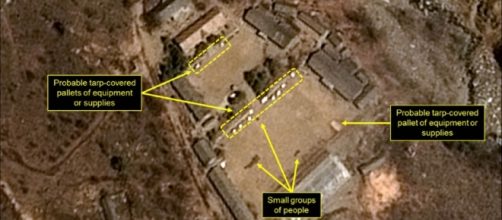Nuclear Concerns as North Korea prepare to celebrate the "DAY OF THE SUN"
Approximately 200 reporters including those from Japan and U.S are in the capital of North Korea Pyongyang, as the North Korean's prepare to celebrate the "Day Of The Sun" on April 15th, marking the 105th anniversary of the birth of the countries founder and Kim Jong-un's grandfather Kim II Sang, there are growing concerns that the North just might be planning to hold it's 6th Nuclear test in a decade, even though historically they have never done Nuclear tests on this date.
These concerns are raised due to satellite images from U.S- based monitoring group 38 North. The images of the North's Punggye-ri site on the 12th of April showed, "continued activity around the North Portal, new activity in the main administrative area, and a few personnel around the sites command centre" stated 38 North on their website.
Journalists, we're woken up before dawn and told to leave their mobile phones and wear suits and taken to an undisclosed location, where their Supreme Leader Kim Jong-un showed up and opened a new highrise apartment complex in spite of U.N sanctions. However later there were images of Kim Jong-un at a specials operations military exercise, where his commandos were jumping out of aircraft.
Effectively giving off a show of military and economic strength. Japan's Nikkei business paper said on Thursday that the U.S had sent a "sniffer" plane to Japan to monitor any nuclear tests.
North Korea historically marks significant dates with shows of military force and analysts presume that they might detonate a Nuclear weapon to celebrate the birthday this Saturday.
Doing this will, however, serve as a big test to Trumps already aggressive stance towards the North.
Nuclear Activity
Mt. Mantap is the world's only active nuclear test site after most other nuclear states gave us such activity in a bid to end arms races and their costly repercussions of military actions and reactions. North Korea does their testing by burying approximately 5,000 feet high, that's about halfway up this mountain of 7'234 feet.
Previous test sites five and two were done at 2,625 feet deep with a magnitude of 5.3 and 1,600 feet deep with a magnitude of 4.5. To prevent radioactive spilling the test site is usually partly backfilled, and underground tunnels culminate in a hook, allowing them to seal themselves up after a blast. A design believed to have come from Pakistani nuclear tests.
Experts now rely on a kind of seismologic data used to track earthquakes to pinpoint the geographic site of a nuclear blast. Each of the Norths detonations generated shock waves that registered across the globe. By spacing their nuclear tests, doing 5 in a span of 10 years, Siegfried S. Hecker a former director of the Los Alamos weapons laboratory in New Mexico, the birthplace of the atomic bomb stated, "You can learn a lot in that time."
Nine countries are known to possess nuclear arms, most having advanced from simple atomic bombs to more complicated hydrogen bombs.
Nuclear experts estimate North Korea is between stage 1 and 3, an intermediate stage of development. Stating that the way to achieve more destructive power is by raising the amount of thermonuclear fuel that an exploding atom bomb can ignite.

